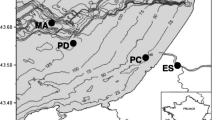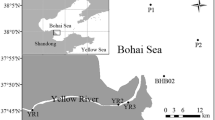Abstract
The abundance of sulphate-reducing bacteria (SRB) was investigated in the coastal marine sediments along the coast of Japan and South Korea. Sediment samples were collected from fish and shellfish farms between 2006 and 2008. As non-fish farming reference sites, sediments were also collected from highly eutrophic bays, a highly sulphidogenic saline lake, and the deep sea. A quantitative real-time PCR analysis that targeted the gene coding for a portion of the α-subunit of dissimilatory sulphite reductase (dsrA) was performed to assess the abundance of the SRB in the sediments. Between 2.8 × 107 and 2.5 × 109 copies of the dsrA gene per gram dry sediment were detected. There was no relationship between dsrA gene copy number and total bacterial count in the sediments, whereas organic matter contents (particulate organic carbon and nitrogen, ignition loss and chemical oxygen demand) and acid-volatile sulphide contents were significantly correlated with the dsrA copy number. The data presented demonstrate that organic enrichment of sediment may influence the abundance of SRB communities in coastal marine sediments and that the cell density of SRB may be used as a biological indicator for assessing pollution levels in sediments of marine fish farms.
Similar content being viewed by others
References
Asami H, Aida M, Watannabe K (2005) Accelerated sulfur cycle in coastal marine sediment beneath areas of intensive shellfish aquaculture. Appl Environ Microbiol 71:2925–2933
Holmer M, Kristensen E (1996) Seasonality of sulfate reduction and pore water solutes in a marine fish farm sediment: the importance of temperature and sedimentary organic matter. Biogeochemistry 32:13–39
Kawahara N, Shigematsu K, Miyadai T, Kondo R (2009) Comparison of bacterial communities in fish farm sediments along an organic enrichment gradient. Aquaculture 287:107–113
McCaig AE, Phillips CJ, Stephen JR, Kowalchuk GA, Harvey SM, Herbert RA, Embley TM, Prosser JI (1999) Nitrogen cycling and community structure of proteobacterial β-subgroup ammonia-oxidizing bacteria within polluted marine fish farm sediments. Appl Environ Microbiol 65:213–220
Bissett A, Bowman J, Burke C (2006) Bacterial diversity in organically-enriched fish farm sediments. FEMS Microbiol Ecol 55:48–56
Kondo R, Nedwell DB, Purdy KJ, Silva SQ (2004) Detection and enumeration of sulphate-reducing bacteria in estuarine sediments by competitive PCR. Geomicrobiol J 21:145–157
Kondo R, Shigematsu K, Butani J (2008) Rapid enumeration of sulphate-reducing bacteria from aquatic environments using real-time PCR. Plankton Benthos Res 3:180–183
Leloup J, Loy A, Knob NJ, Borowski C, Wagner M, Jørgensen BB (2007) Diversity and abundance of sulfate-reducing microorganisms in the sulfate and methane zones of a marine sediment, Black Sea. Environ Microbiol 9:131–142
Schippers A, Neretin LN (2006) Quantification of microbial communities in near-surface and deeply buried marine sediments on the Peru continental margin using real-time PCR. Environ Microbiol 8:1251–1260
Webster G, Parkes RJ, Cragg BA, Newberry CJ, Weightman AJ, Fry JC (2006) Prokaryotic community composition and biogeochemical processes in deep subseafloor sediments from the Peru Margin. FEMS Microbiol Ecol 58:65–85
Kawahara N, Shigematsu K, Miura S, Miyadai T, Kondo R (2008) Distribution of sulfate-reducing bacteria in fish farm sediments on the coast of southern Fukui Prefecture, Japan. Plankton Benthos Res 3:42–45
Kondo R (2000) Microbiological methods for assessment of marine environments (in Japanese). In: Ishida Y, Sugita H (eds) Sulfide. Kouseisha-Kouseikaku, Tokyo, pp 27–30
Ogura K (1986) Organic carbon and nitrogen. In: The Oceanographic Society of Japan (ed) Coastal environments investigation manual (volume of sediments and organisms) (in Japanese). Kouseisha-Kouseikaku, Tokyo, pp 57–59
Eguchi M (2000) Chemical oxygen demand (in Japanese). In: Ishida Y, Sugita H (eds) Microbiological methods for assessment of marine environments. Kouseisha-Kouseikaku, Tokyo, pp 32–35
Japan Fisheries Resource Conservation Association (2005) Environmental standards for aquaculture, 2005 (in Japanese). Japan Fisheries Resources Conservation Association, Tokyo
Kimata M, Kadota H, Hata Y, Tajima T (1955) Studies on the marine sulfate-reducing bacteria. I. Distribution of marine sulfate-reducing bacteria in the coastal waters receiving a considerable amount of pulp mill drainage (in Japanese). Nippon Suisan Gakkaishi 21:102–108
Ishida Y (1982) Eutrophication and biological indicators, 1 bacteria. In: Yoshida Y et al (eds) Eutrophication and biological indicators in coastal waters (in Japanese). Kouseisha-Kouseikaku, Tokyo, pp 11–26
Kondo R (1992) Anaerobic mineralization process of organic matter with reference to sulfate reduction in marine sediments (Uranouchi Inlet, Japan). PhD thesis. Ehime University, Ehime
Kondo R, Butani J (2007) Comparison of the diversity of sulfate-reducing bacterial communities in the water column and the surface sediments of a Japanese meromictic lake. Limnology 8:131–141
Japan Fisheries Resource Conservation Association (1995) Environmental standards for aquaculture, 1995 (in Japanese). Japan Fisheries Resources Conservation Association, Tokyo
Okabe S, Nielsen PH, Characklis WG (1992) Factor affecting microbial sulfate reduction by Desulfovibrio desulfuricans in continuous culture: limiting nutrients and sulfide concentration. Biotechnol Bioeng 40:725–734
Reis MAM, Almeida JS, Lemos PC, Carrondo MJT (1992) Effect of hydrogen sulfide on the growth of sulfate reducing bacteria. Biotechnol Bioeng 40:593–600
Dalsgaard T, Bak F (1994) Nitrate reduction in a sulfate-reducing bacterium, Desulfovibrio desulfuricans, isolated from rice paddy soil: sulfide inhibition, kinetics, and regulation. Appl Environ Microbiol 60:291–297
Postgate JR (1984) The sulphate-reducing bacteria, 2nd edn. Cambridge University Press, Cambridge
Kondo R, Purdy KJ, Silva SQ, Nedwell DB (2007) Spatial dynamics of sulphate-reducing bacterial compositions in sediment along a salinity gradient in a UK estuary. Microbes Environ 22:11–19
Rabus R, Hansen TA, Widdel F (2006) Dissimilatory sulfate- and sulfur-reducing prokaryotes. In: Dworkin M et al (eds) The prokaryotes, vol 2, 3rd edn. Springer, New York, pp 659–768
Acknowledgements
We thank N. Nishibori and S. Nishio from Shikoku University; H. Maeda from Mie University; K. Abo, Y. Ishihi and T. Takashi from the National Research Institute of Aquaculture, Fisheries Research Agency; Y. Hayashi from the Kochi Prefectural Fisheries Experiment Station; and I. L. Noh and S. W. Park from Chonnam National University for their help with the field investigations. We also thank fish farm managers I. Hashimoto, S. Nakamu, Y. Shimojo and K. Yamakawa for their field assistance. We are grateful to the captain and the crew of the R/V Tanseimaru for their skillful help in sampling at Tokyo and Sagami Bays. This study was supported in-part by a Grant-in-Aid for Scientific Research from the Japan Society for the Promotion of Science and the Fisheries Agency of Japan to RK.
Author information
Authors and Affiliations
Corresponding author
Electronic supplementary material
Below is the link to the electronic supplementary material.
Rights and permissions
About this article
Cite this article
Kondo, R., Shigematsu, K., Kawahara, N. et al. Abundance of sulphate-reducing bacteria in fish farm sediments along the coast of Japan and South Korea. Fish Sci 78, 123–131 (2012). https://doi.org/10.1007/s12562-011-0439-3
Received:
Accepted:
Published:
Issue Date:
DOI: https://doi.org/10.1007/s12562-011-0439-3




